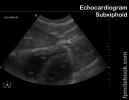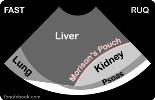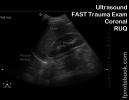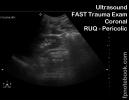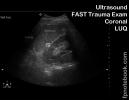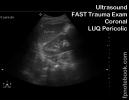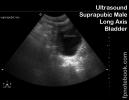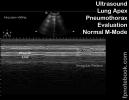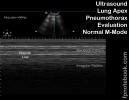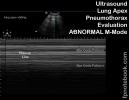FAST Exam, eFAST Exam, Extended FAST Exam, Focused Assessment with Sonography for Trauma, Limited Trauma Ultrasound, Focused Assessment with Ultrasonography for Trauma, Ultrasound of Abdomen for FAST Exam
- See Also
- Subcostal Echocardiogram View (Subxiphoid Echocardiogram View)
- Right Intercostal Oblique Ultrasound View
- Right Coronal Ultrasound View
- Left Intercostal Oblique Ultrasound View
- Left Coronal Ultrasound View
- Suprapubic Ultrasound View (Long Axis or Longitudinal View)
- Lung Ultrasound for Pneumothorax (Sliding Lung Sign, Lung Point)
- Emergency Echocardiography
- Ultrasound
- Indications
- Blunt Chest or Abdominal Trauma
- Identify life-threatening, Trauma-related conditions requiring emergent intervention
- Pericardial Effusion
- Hemoperitoneum
- Hemothorax
- Pneumothorax
- Background
- FAST Exam typically takes 2-4 minutes depending on level of experience
- May take as little as 10 seconds for each of the 7 views
- FAST Exam is an integral part of the Trauma Primary Survey
- In some centers, FAST Exam is performed in place of auscultation of lungs and heart as part of the Primary Survey
-
Chest evaluation is the highest yield portion of the FAST Exam
- Chest findings are immediately actionable without further testing (although CT Chest may be performed)
- Pleural EffusionTest Sensitivity approaches 100%
- Pericardial Effusion and Cardiac TamponadeTest Sensitivity approaches 100%
- Pneumothorax evaluation Test Sensitivity approaches 100%
- Contrast with identification of abdominal free fluid for which Test Sensitivity varies from 22-85%
- FAST Exam will miss early or slow intraabdominal Hemorrhage
- Often requires CT Abdomen for definitive diagnosis (or serial FAST Exam)
- Chest findings are immediately actionable without further testing (although CT Chest may be performed)
- Precautions
- Repeat serial FAST Ultrasound exams
- Initial scan often misses important findings (typically due to haste of completing full survey)
- FAST Exam Test Sensitivity and Test Specificity significantly increases when repeated (at 3-6 hours)
-
Pleural Effusion and Hemothorax (right and left intercostal views)
- Air in lung normally obscures lung and diaphragm appearance
- Pleural Effusion and Hemothorax by contrast appear black, anechoic and enhance the lung boundary
- Abdominal FAST Exam is most helpful when positive (see efficacy below)
- FAST Exam is at best, a "rule-in" test to direct emergent surgical management in acute significant Trauma
- Identifies large volumes of intraabdominal blood
- Morrison's Pouch (right coronal) is most useful view and most likely site to identify intraabdominal blood
- Test Sensitivity increases when performed with patient in Trendelenburg position (may replace left coronal and suprapubic views)
- If positive in Trendelenburg position, but negative when supine, may quantify as smaller volume of blood
- FAST Exam should NOT be used as a "rule-out" test (esp. Abdominal Trauma) to replace definitive imaging
- A negative FAST Exam does not have adequate Test Sensitivity (especially in blunt Trauma) to reassure
- A negative FAST Exam should not dissuade CT Abdomen or exploratory surgery in Abdominal Trauma
- FAST Exam is at best, a "rule-in" test to direct emergent surgical management in acute significant Trauma
- Complelety visualize common areas of missed fluid pockets
- Right Coronal Ultrasound View
- Lower tip of the liver (follow morrison's pouch medially and inferiorly)
- Suprapubic Ultrasound View
- Fluid pocket is superior (screen left) and deep to Bladder in long axis (probe indicator 12:00)
- Left Coronal Ultrasound View
- Right Coronal Ultrasound View
- Modifications for children
- RUQ (Morrison's Pouch) and LUQ (Splenorenal) views are anterior in children (compared with adults)
- Position probe at mid-axillary line for RUQ and LUQ in children
- RUQ (Morrison's Pouch) and LUQ (Splenorenal) views are anterior in children (compared with adults)
- Efficacy
- FAST Exam is operator dependent for identifying free fluid
- Only 10% of fast users detect <400 cc free fluid on FAST Exam
- Skilled ultrasonagraphers can detect down to 100 cc free fluid (200 cc on average)
- Free fluid in Penetrating Trauma
- Test Sensitivity varies from 50-80%
- Free Fluid in Blunt Abdominal Trauma
- Stable Patient Test Sensitivity: 22%
- Unstable PatientTest Sensitivity: 28%
- Test Sensitivity when CT showed free fluid: 35%
- Carter (2014) Injury 46(5):817-21 +PMID:25498329 [PubMed]
- Preparation
- Ultrasound
- Transducer selection
- Low frequency probe (deeper penetration): 3-5 MHz Curved Linear Probe
- Transducer indicator positioning is based on the patient's body as a clock face
- Head: 12:00
- Left hand: 3:00
- Feet: 6:00
- Right hand: 9:00
- Transducer orientation
- Use long access (12:00) positioning for most views of Abdomen and chest
- Exception: Subcostal or subxiphoid view
- Rotation of probe along rib margins to reduce rib shadowing is typically needed
- Rotating probe slightly into oblique orientation may decrease rib shadowing
- Use long access (12:00) positioning for most views of Abdomen and chest
- Patient position
- Abdominal views are best obtained with patient flat (supine) or in trendeleburg position
- Views
- Subcostal Echocardiogram View (Subxiphoid Echocardiogram View)
- Right Intercostal Oblique Ultrasound View
- Right Coronal Ultrasound View
- Left Intercostal Oblique Ultrasound View
- Left Coronal Ultrasound View
- Suprapubic Ultrasound View (Long Axis or Longitudinal View)
- Lung Ultrasound for Pneumothorax (Sliding Lung Sign, Lung Point)
- Resources
- Set-up
- FAST Exam - System Set-up (Dr. Mandavia, SonoSite)
- Subcostal
- FAST Exam Subcostal (Dr. Mandavia, Sonosite)
- Right Upper quadrant
- FAST Exam RUQ (Dr. Mandavia, Sonosite)
- FAST Exam RUQ -Normal (Dr. Mandavia, Sonosite)
- FAST Exam RUQ - Hemorrhage (Dr. Mandavia, SonoSite)
- Left Upper quadrant
- Left upper quadrant
- FAST Exam LUQ (Dr. Mandavia, Sonosite)
- Left upper quadrant
- Suprapubic
- FAST Exam Suprapubic (Dr. Mandavia,SonoSite)
- FAST Exam Female Pelvis (Dr. Mandavia, SonoSite)
- Fast Exam Male Pelvis (Dr. Mandavia, SonoSite)
-
Pneumothorax
- FAST Exam - Pneumothorax (SonoSite)
- Pneumothorax (Dr. Perera, SonoSite)
- References
- Reardon (2016) Gallbladder Ultrasound, Stabroom.com online video, accessed 4/1/2016
- Reardon (2013) Emergency Ultrasound Course, 3rd Rock Ultrasound, Minneapolis, MN
- Alameda County Trauma Service FAST Exam
- Mateer (2012) Introduction to Trauma Ultrasound Video, GulfCoast Ultrasound, VL-95-T
- HCMC FAST Exam

